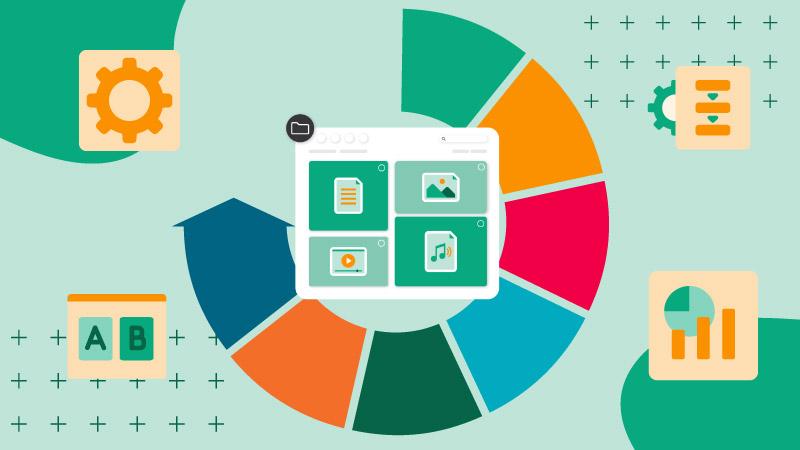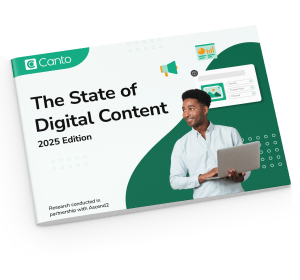How to maximize marketing efficiency with DAM software
| May 21, 2025

As content demands skyrocket, marketing teams are under increasing pressure to produce more, faster, and better – all while maintaining brand consistency. Most teams also need to increase content production and quality with dwindling resources. That’s why marketing efficiency is essential to achieving modern marketing goals.
Top highlights
- Marketing efficiency drives results: Getting to market faster without sacrificing quality gives teams a competitive edge.
- Workflow friction adds ups: Delays, duplicate work, and misalignment waste time, money, and morale.
- Better processes = bigger impact: Streamlined marketing workflows boost speed, consistency, and performance.
What is marketing efficiency – and why does it matter today?
Marketing efficiency is the ability to maximize output while minimizing wasted time, resources, and effort. It’s measured by how quickly and cost-effectively your team can go from ideation to launch without sacrificing quality.
At its core, marketing efficiency means delivery high-quality, high-performing content and campaigns on time and on budget. Unlocking marketing efficiency means reducing friction across your team’s workflows so your best ideas can go from concept to execution with minimal delay.
High-performing marketing teams understand that efficiency sets them apart. It allows them to respond faster to market changes, stretch budgets further, and execute campaigns that move the needle. However, efficiency isn’t easy to achieve in a fragmented content ecosystem, which involves:
- Disjointed content operations
- Siloed teams
- Manual asset management
Having a fragmented content ecosystem leads to:
- Campaign delays
- Creative bottlenecks
- Unnecessary brand risk

Inefficiencies in the modern marketing workflow
Even the most talented teams struggle with broken marketing workflows. Let’s break down where those inefficiencies tend to live:
- Endless asset searching: Marketers waste hours each week hunting down the correct file or struggling with version control.
- Approval roadblocks: Feedback loops are slow, scattered, and unclear, delaying time to market.
- Creative bottlenecks: Creatives get overwhelmed with redundant requests and spend more time fielding questions than designing.
- Duplicate work: Teams recreate assets that already exist because they can’t find or access them easily.
These blockers create a ripple effect across marketing, creative, and brand teams. Campaigns get delayed. Deadlines get missed. Morale and overall performance suffer. Beyond the frustration they cause, these inefficiencies are expensive. The costs add up quickly from extra design hours to missed revenue opportunities.
Thankfully, digital asset management (DAM) software gives marketing teams a way to centralize their content library, empowering them to create, collaborate, and deliver content from a single, unified workflow. By streamlining inefficiencies across the entire content process, teams can unlock serious cost savings and drive the kind of operational efficiency that makes a compelling business case for digital asset management (DAM) software.

Do these pain points sound familiar?
How to measure marketing efficiency
Improving efficiency starts with knowing how to measure it. Here are four key metrics that help quantify marketing performance and efficiency:
Marketing efficiency ratio (MER)
Total revenue / total marketing spend
MER shows how effectively your team is turning marketing investment into top-line growth.
Return on marketing investment (ROMI)
(Revenue attributed to marketing – marketing cost) / marketing cost
Unlike MER, ROMI focuses on profitability by measuring how much net profit your marketing generates relative to what you spend.
Customer acquisition cost (CAC)
Total sales + marketing cost / number of new customers acquired
CAC tells you exactly how much it costs to acquire a new customer. Lower CAC indicates greater efficiency.
Customer lifetime value (CLTV)
Average purchase value x number of purchases per year x average customer lifespan
CLTV estimates how much revenue a customer will generate over the entirety of their relationship with your brand. A high CLTV relative to CAC signals sustainable marketing efficiency.
Tracking these KPIs over time allows you to identify what’s working, uncover areas for improvement, and justify future investments in tools and tactics that improve marketing efficiency.
Strategies to improve marketing efficiency across the content lifecycle
To boost marketing performance, teams need to streamline processes, focus on what works, and remove inefficiencies. Here are five key strategies to improve marketing efficiency.
- A single source of truth for content: Full optimize content lifecycle management by adopting a DAM system, so teams can move faster without sacrificing quality.
- Channel optimization: Focus on platforms that consistently deliver the best results. Use performance data to prioritize high-ROI channels and eliminate ineffective ones. DAM software supports this by tracking asset usage and making it easy to tailor content for each channel.
- Marketing automation tools: Leverage automation to eliminate repetitive tasks, streamline campaign execution, and free up your team’s time for higher-value work. For example, a DAM platform helps teams automate content organization, approval workflows, and more.
- A/B testing and audience segmentation: Continuously test and refine your messaging to reach the right audience with the right message. A DAM system ensures you can quickly locate and deploy the right creative variations for any test or audience segment.
The efficiency benefits of DAM software
By combining these strategies with the right technology, teams can reduce friction, speed up delivery, and build a more agile, impactful marketing engine. Even if teams face leadership objections to new tech investments, the measurable benefits of DAM software speak for themselves. DAM software is one tool that can significantly boost marketing efficiency, which helps your demonstrate DAM ROI to leaders by showcasing benefits, like:
- Increased speed to market: Take advantage of every opportunity with faster campaign and content launches.
- Streamlined collaboration: Bring teams closer together in a unified content workflow to maximize collaboraiton.
- Stronger brand consistency: Ensure everyone uses the same, approved assets to keep your brand consistent across all touch points.
- Improved team morale and impact: Save teams time and effort, empowering them to focus on strategic priorities that drive performance rather than wrangling content chaos.
Want to learn more about how DAM technology drives marketing efficiency and measurable ROI?

